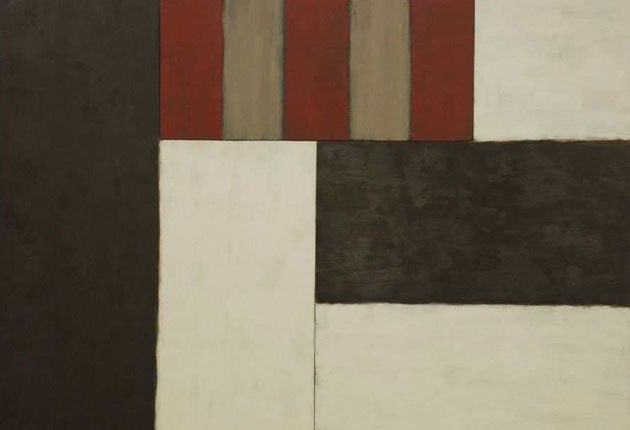Sean Scully: Paintings from the 80s, Timothy Taylor Gallery, London
Rich canvases by the baby of the British modernists slowly come to terms with the fact that paint is flat

Reviewing an exhibition while it is being hung is a tricky business.
Walking around the new Sean Scully show at the Timothy Taylor Gallery, it wasn't instantly clear what I'd come to see – the industrial vacuum cleaner in the first room might have been a Jeff Koons, for example, the attendant dabbing diligently at a spot of paint a Duane Hanson. The Scullys themselves, oil on canvas, looked negligible in their old-fashionedness. That they were made barely 20 years ago, and that Scully was subsequently twice short-listed for the Turner Prize, seemed impossible to imagine.
The first of the seven canvases in this show, Swan Island, was painted in 1982, the last, Dreamland, in 1987. The year after, Damien Hirst's exhibition, Freeze, brought the YBAs to the public eye. In the two decades that have followed, only two painters have won the Turner Prize and neither of those – Chris Ofili and Tomma Abts – can be counted as painterly in the sense that Scully is painterly. The works in this show represent an end-point in British (and maybe in contemporary) art, the last time a painter could work as a modernist rather than as a postmodernist. Successful artists who wield the brush sincerely today tend to be oldies such as Lucian Freud (86), Bridget Riley (77), Howard Hodgkin (76) or Scully himself (63). Younger painters who have made it (Martin Kippenberger et al) fly their oils as a flag of convenience, a conceptual medium among many.
So what you might expect of this tight little show – roughly one canvas from each year, 1982-87 – are signs of crisis. Scully was in his mid-thirties when he painted these works, a young turk at the top of his game and, as his Turner Prize shortlistings suggest, at the top of the tree. The quick triumph of conceptualism over canvas cannot just be put down to a sulphurous alliance of Hirst, Rosenthal and Serota. Painting must also have hit the historical buffers, and Scully must have seen those buffers coming.
That is certainly the feeling conveyed by the works in this show. It's arguable that the main problem painting faced by the 1980s was its two-dimensionality. For a century, modernism had insisted that the flatness of a painted surface be acknowledged. Visit Tate Modern's excellent Rothko show – it ends on 1 February, so do not tarry – and you'll see the great man trying to get around this rule, sometimes fetishising the edges of his canvases as frames, sometimes continuing his surface on to them so as to make them seem sculptural. In the 1980s, Scully took this anxiety a step further by making paintings that actually were three-dimensional, the various elements of their multi-part canvases standing proud of each other like undulating diptychs and triptychs.
Frankly, it is not a success. The Bather (1983) clearly sits at the end of a modernist experiment begun, as the work's title suggests, by Cézanne. The recessed panels read as background, the tall "front" panel as foreground. The former are painted in vertical stripes of sludge green and ultramarine dragged over an orange base, the latter in horizontal stripes of the same orange. The colours are like a post-Pop condensing of Cézanne's palette, the stripes an abstraction of Cézanne's blocks of paint. But the result is a grim collision of Hockney and Daniel Buren, like a loud school tie.
Scully's frustration with the flatness of painting also shows through in his brushwork, particularly in Red Earth (1985). Apparently dragged on with a household brush, the surface of this is so striated as to look like faux wood. It is only in the show's last picture that Scully surrenders and reconciles himself to painting's flatness. Dreamland is a lovely work, its level surface as buffed as a Rothko and its palette as sober. It is the kind of painting that has stood the artist in good stead for 20 years now, full of the sombre elegance beloved of his fans, of which I am one. But it is a work whose present lies in its past; which has, unless things change a great deal, no future at all.
Timothy Taylor Gallery, London W1 (020-7409 3344) to 14 Feb
Subscribe to Independent Premium to bookmark this article
Want to bookmark your favourite articles and stories to read or reference later? Start your Independent Premium subscription today.

Join our commenting forum
Join thought-provoking conversations, follow other Independent readers and see their replies